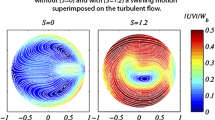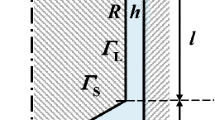Abstract
The use of nonstandard geometries like the vane is essential to measure the rheological characteristics of complex fluids such as non-Newtonian fluids or particle dispersions. For this geometry which is of Couette type, there is no analytical simple model defining the relation between the shear stress and the torque or relating the angular velocity to the shear rate. This study consists on calibrating a nonstandard vane geometry using a finite volume method with the Ansys Fluent software. The influence of geometrical parameters and rheological characteristics of the complex fluids are considered. First, the Newtonian fluid flow in a rotative vane geometry was simulated and a parametric model is derived therefrom. The results show an excellent agreement between the calculated torque and the measured one. They provide the possibility to define equivalent dimensions by reference to a standard geometry with concentric cylinders where the relationships between shear stress (resp. shear rate) and the torque (resp. the angular rotation) are classical. Non-Newtonian fluid flows obeying a power law rheology with different indices were then simulated. The results of these numerical simulations are in very good agreement with the preceding Newtonian-based model in some ranges of indices. The absolute difference still under 5 % provided the index is below 0.45. Finally, this study provides a calibration protocol in order to use nonstandard vane geometries with various heights, gaps, and distance to the cup bottom for measuring the rheology of complex fluids like shear thinning fluids and concentrated suspensions.














Similar content being viewed by others
Notes
The shear stress factor is calculated for a mean stress between the outer and inner radius: \(\sigma = \frac {\sigma (R_{1})+\sigma (R_{2})}{2}\)
In the experiments presented in section “Experimental validation of the numerical model for a Newtonian fluid, ” the Reynolds number range is 0.0025 ⩽ Re ⩽ 0.04 and the Froude number is Frq = 10−3
The notation ”Geo 20-30-5” here denotes a vane geometry with diameter d 1 = 20mm, external cylinder diameter d 2 = 30mmand distance to the bottom of the cup dq = 5mm.
References
Ait-Kadi A, Marchal P, Choplin L, Chrissemant AS, Bousmina M (2002) Quantitative analysis of mixer-type rheometers using couette analogy. Canad J Chem Engen 80:1166–1174
ANSYS® (2012) Fluent—Academic Research Release 14.0, ANSYS, Inc
Barnes HA, Carnali JO (1990) The vane-in-cup as a novel rheometer geometry for shear thinning and thixotropic materials. J Rheol 34:841–866
Boger DV (2013) Rheology of slurries and environmental impacts in the mining industry. Annu Rev Chem Biomol Eng 4:239–257
Bousmina M, Ait-Kadi A, Faisant JB (1998) Determination of shear rate and viscosity from batch mixer data. J Rheol 43(2):415– 433
Couarraze G, Grossiord JL (2000) Initiation la rhologie. Tec & Doc Lavoisier
Derakhshandeh B, Hatzikiriakos S, Bennington C (2010) The apparent yield stress of pulp fiber suspensions. J Rheol 54:1137–1154
Estelle P, Lanos C (2012) High torque vane rheometer for concrete: principle and validation from rheological measurements. Appl Rheol 22:12, 881
Fisher DT, Clayton SA, Boger DV, Scales PJ (2007) The bucket rheometer for shear stress-shear rate measurement of industrial suspensions. J Rheol 51:821–831
Keentok M (1982) The measurement of the yield stress of liquids. Rheol Acta 21:325–332
Krulis M, Rohm H (2004) Adaption of a vane tool for the viscosity determination of flavoured yoghurt. Eur Food Technol 218:598–601
Nguyen QD, Boger DV (1983) Yield stress measurement for concentrated suspensions. J Rheol 27(4):321–349
Nguyen QD, Boger DV (1985) Direct yield stress measurement with the vane method. J Rheol 29(3):335–347
Ovarlez G, Bertrand F, Rodts S (2006) Local determination of the constitutive law of a dense suspension of noncolloidal particles through magnetic resonance imaging. J Rheol 50(3):259–292
Ovarlez G, Mahaut F, Bertrand F, Chateau X (2011) Flows and heterogeneities with a vane tool: magnetic resonance imaging measurements. J Rheol 55:197–223
Potanin A (2010) 3d simulations of the flow of thixotropic fluids, in large-gap couette and vane-cup geometries. J Non-Newton Fluid Mech 165:299–312
Rabia A, Djabourov M, Feuillebois F, Lasuye T (2010) Rheology of wet pastes of PVC particles. Appl Rheol 20:11961(9 pages)
Roos H, Bolmstedt U, Axelsson A (2006) Evaluation of new methods and measuring systems for characterisation of flow behaviour of complex foods. Appl Rheol 16:19–25
Savarmand S, Heniche M, Béchard V, Bertrand F, Carreau PJ (2007) Analysis of the vane rheometer using 3d finite element simulation. J Rheol 51(2):161–177
Sherwood JD, Meeten GH (1991) The use of the vane to measure the shear modulus of linear elastic solids. J Non-Newton Fluid Mech 41:101–118
Author information
Authors and Affiliations
Corresponding author
Appendices
Appendix A: Data results
Appendix B: Linear fit of the experimental torque results
The relative errors on R 1eqv and H eqv are then calculated from the relative error on the torque measurement.
Appendix C: Variation of F γ /F γN versus R 2/R 1
Rights and permissions
About this article
Cite this article
Rabia, A., Yahiaoui, S., Djabourov, M. et al. Optimization of the vane geometry. Rheol Acta 53, 357–371 (2014). https://doi.org/10.1007/s00397-014-0759-1
Received:
Revised:
Accepted:
Published:
Issue Date:
DOI: https://doi.org/10.1007/s00397-014-0759-1






